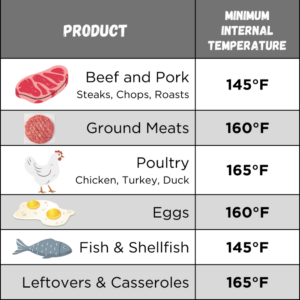by Nutrition Program Director, Danielle Maguire, RDN
September is National Food Safety Education Month – a great time to focus on prevention of food-borne illness, proper food preparation, and when to throw away expired foods. An estimated 1 in 6 Americans get food poisoning each year, which can lead to hospitalization and even death, but you can take steps to prevent it!
What is cross-contamination?
Cross-contamination is the transfer of harmful bacteria to food from other foods, cutting boards, or utensils when it is handled improperly. This harmful bacteria is often found in raw meat, poultry, egg and seafood, so we want to be sure to handle these things properly! Keep these raw foods and their juices away from already cooked or ready-to-eat foods and fresh products. Hand washing is a necessity!
How can I avoid food poisoning and cross-contamination?
You can’t see, smell or taste harmful bacteria that may cause illness, so it’s important to follow these key steps in food handling, cooking, and storage to prevent food-borne illness:
- Clean: Start with clean hands, utensils and surfaces. Cleaning is not just important at the start – be sure to regularly wash your hands and tools throughout food preparation.
- Separate: Keep raw meat and poultry separate from cooked foods or other foods that will not be cooked until later in the process. This includes tools like knives, cutting boards, or plates.
- Cook: Always cook your food to a safe minimum internal temperature with a food thermometer. This will ensure any harmful bacteria in your food has been killed before you eat it.
- Chill: Keep perishable foods in your refrigerator or freezer – below 40°F. Do not leave perishable foods at room temperature for more than 2 hours. If you’d like to save these foods, plan to use or freeze leftovers within four days of when you first cooked them.
 How do I know when my food is expired?
How do I know when my food is expired?
Depending on what food you are buying, the date on the package could be a recommendation on when it’s sold or by when it should be eaten by. Since confusion surrounding a date could mean throwing out perfectly good food, here is some information about food package dates!
- Sell-By: This date tells the store how long to display the product for sale. You should buy the product before the date expires.
- Best if Used By (or Before): This date is recommended for best flavor or quality. It is not a purchase or safety date.
- Use-By: Date is the last date recommended for the use of the product while at peak quality – the expiration date. The date has been determined by the manufacturer of the product.
Now is a great time to look through your pantry and refrigerator for items that you should throw away. Leftovers can be kept for ~4 days safely in the refrigerator, after that however, the risk of food poisoning increases. If you don’t think you’ll be able to eat leftovers within 4 days, it’d be a good idea to freeze them!
Pasta Primavera
Pasta Primavera is a perfect “rainbow veggie pasta” recipe for this time of year to utilize your garden vegetables! This is a versatile recipe so that you can use whatever vegetables you have on hand. A vegetable-packed dish means that it provides tons of great vitamins and nutrients – all in a simple, delicious pasta dish with olive oil and herbs.
Yield: 6 servings, Prep Time: 10 min
Cook Time: 25 min, Total Time: 35 min
Ingredients
- 10 ounces of penne pasta, or 3 ½ cups
- ⅓-½ cup pasta water
- ¼ cup olive oil
- 1 teaspoon salt, divided
- 1 teaspoon dried oregano, divided
- ½ teaspoon black pepper, divided
- 2 Tablespoons salted butter
- 2 carrots, diced
- ½ red onion, diced
- 1 red bell pepper, diced
- 1 cup broccoli florets, cut into 1-inch pieces
- 1 yellow squash, quartered and sliced
- 1 cup grape tomatoes, cut in half
- 1 Tablespoon white wine vinegar
- 1 teaspoon garlic powder
- ¼ teaspoon dried basil
- Optional garnishes: Shredded Parmesan cheese, Chopped Parsley
Instructions
- Cook pasta according to the directions on the bag. Drain but save 1 cup of the pasta water and set aside. I like to ladle out 1 cup and put it into a separate container before I drain it.
- In a small bowl, mix the olive oil, ½ teaspoon salt, ¼ teaspoon black pepper, and ½ teaspoon oregano.
- Toss the pasta with this oil mixture until evenly covered. Set pasta aside.
- In a large skillet over medium heat, melt the butter and sauté the carrots and onions together until softened, about 2-3 minutes.
- Add in the bell pepper and broccoli florets and cook for a few minutes or until barely softened, about 2-3 minutes.
- Finish up the sauté by adding in the squash, tomatoes, white wine vinegar, garlic powder, ½ teaspoon oregano, ½ teaspoon salt, dried basil, and ¼ teaspoon black pepper. Let cook all together for another 3 minutes.
- Stir in the penne pasta prepared earlier and ⅓ cup of the reserved pasta water to the mixture. Stir for a minute and then remove from heat.
- Plate and garnish with optional Parmesan cheese and parsley and enjoy!
Nutrition Facts per Serving: 391 Calories, 9 gm Protein, 21 gm Fat, 6 gm Fiber, 44 gm Carbohydrates

